Sapa is a scenic wonder located in the northwest of the motherland, in a highland district of Lao Cai province, Vietnam. Sapa is a renowned tourist destination in the entire country, situated approximately more than 30 km away from the city center of Lao Cai. It is located at an average altitude of 1500 – 1800 meters above sea level. Sapa is perpetually shrouded in thick fog, creating a floating sensation and painting a mesmerizingly beautiful and surreal landscape.
This place possesses an invaluable resource – its year-round pure and cool climate, with an average temperature of 15-18°C. In the winter, one can even witness the picturesque scene of snow blanketing Sapa.
Table of Contents
Introduction to Sapa
Visitors come to the Sapa tourist area not only to enjoy the fresh and serene atmosphere of a region in the Northwest but also to admire the pristine beauty of the Northwest mountains and forests. These include terraced fields, waterfalls, majestic peaks, and the exploration of the customs and cultures of mountainous ethnic groups such as the Black H’mong, Red Dao, Tay, and Dzay.
The name “SaPa” comes from the local dialect. In the dialect, “Sa” means sand, and “Pả” means beach. This place name refers to the “sand beach” located on the right side of the road at kilometer 32 from Lao Cai to Sa Pa. In the past, before the town of Sa Pa was established, the local residents would gather at this “sand beach” for their marketplace. Therefore, the local people commonly referred to it as “going to Sa Pả market.”
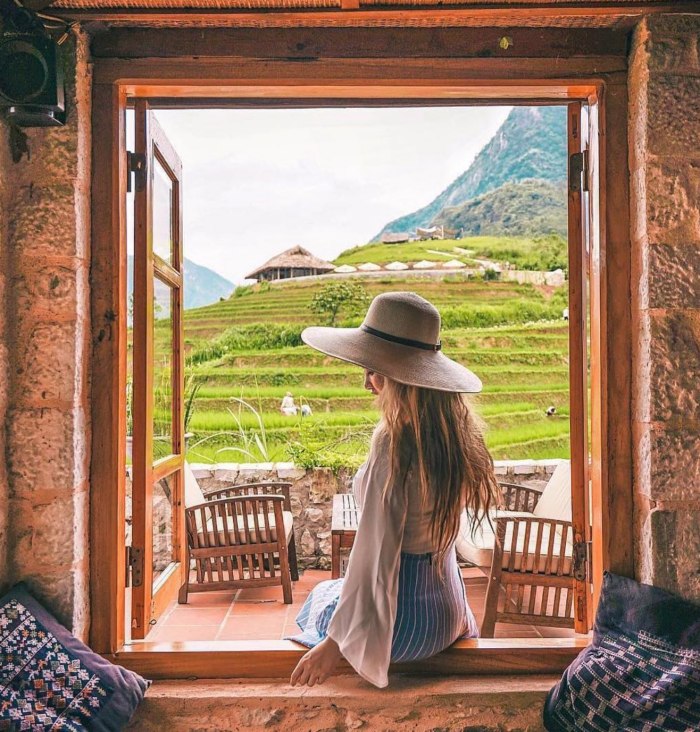
Sapa has a climate with temperate and subtropical characteristics, offering a cool and refreshing atmosphere. The weather in the town exhibits four distinct seasons in a day: the morning resembles spring, with mild temperatures; at noon, it feels like summer, often with gentle sunshine; in the afternoon, clouds and mist create a cool autumn-like feeling, and at night, it can be as cold as winter.
The average annual air temperature in Sapa is 15°C. During the summer, the town does not experience the intense heat of coastal plains, with temperatures ranging from 13°C to 15°C at night and 20°C to 25°C during the day. In winter, it can be cloudy and cold, with temperatures occasionally dropping below 0°C and even snowfall occurring at times. The average annual rainfall in this area is approximately 1,800 to 2,200 mm, with the highest concentration falling between May and August.

Located in the Northwest of Vietnam, the town of Sa Pa sits at an altitude of 1,600 meters above sea level. It is 38 kilometers away from the city of Lao Cai and 376 kilometers from Hanoi. Besides the main road from Lao Cai city, there is another transportation route, National Highway 4D, which connects from Binh Lu commune in Lai Chau province. Although the majority of the residents in Sa Pa district belong to ethnic minority groups, the town itself primarily comprises Kinh people who make a living through agriculture and tourism services.
If you are in Hanoi, Vietnam, and looking for a trip to Sapa, book your journey from Hanoi to Sapa with a private car and driver from VNCarRentals.com’s. Our private car rental service in Hanoi will provide you with an excellent trip, flexible travel time, and professional drivers who will pick you up from anywhere in Hanoi. On the way, you can stop along the route to visit any places you desire without incurring any waiting fees.
When you visit Sapa, you can immediately think of famous tourist destinations like
Fansipan
Fansipan Often referred to as the “Roof of Indochina,” it stands at an elevation of 3,143 meters above sea level, situated in the Hoang Lien Son mountain range. The name Hoang Lien Son comes from the unique Hoang Lien tree found only in this mountain range, which is a rare medicinal plant. The Hoang Lien range is also home to many precious timber trees like Pine. Additionally, it’s a habitat for numerous rare animal species such as pheasants, bears, monkeys, and wild goats. It’s also a sanctuary for a wide variety of rare medicinal plants, with the Hoang Lien Son National Park housing 136 bird species, 56 mammal species, and 553 insect species, including 37 mammals listed in Vietnam’s Red Book. The park boasts 864 plant species, including 173 valuable medicinal plants.
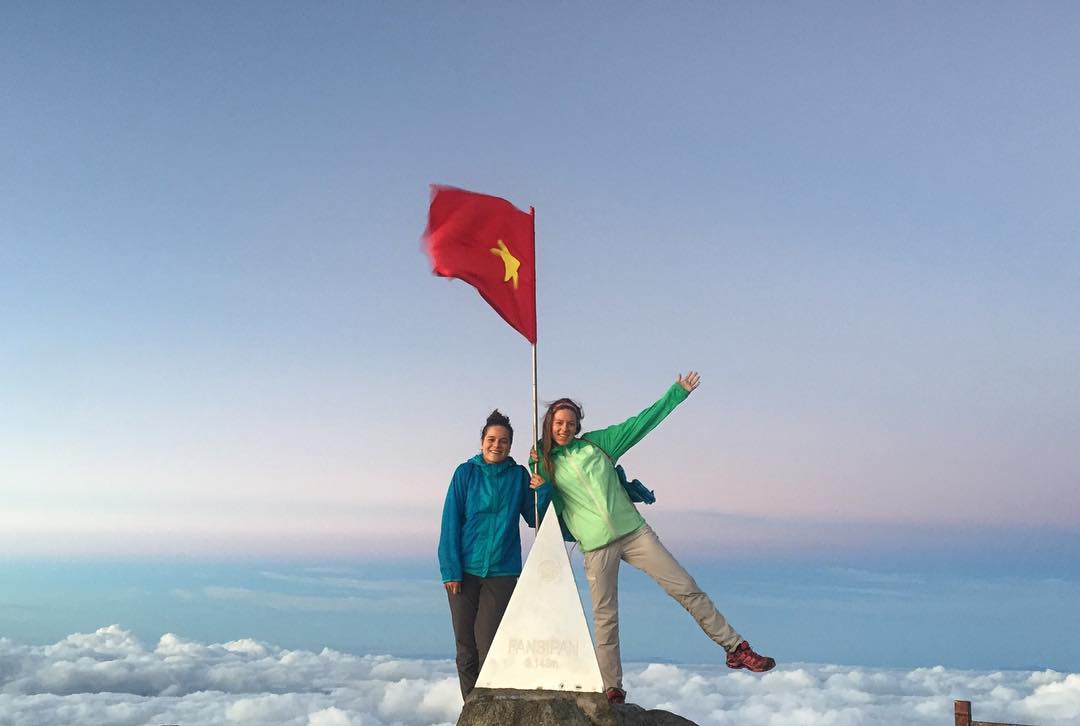
View more detailed articles about: Cable Car Ticket Prices for Fansipan Sapa 2023 Latest Promotion Information
Ham Rong Mountain
One of the most familiar attractions for tourists visiting Sapa is Ham Rong Mountain. It’s a mountain located right in the center of Sapa town. Ham Rong tourist area covers an area of nearly 150 hectares. Construction began in 1996 to exploit the natural and cultural values of mossy rock formations. As you ascend higher, you have the opportunity to explore beautiful landscapes such as Orchid Garden, Heaven Gate, Cloud Yard, and Cherry Blossom Garden. For those who enjoy sightseeing and photography, this is the perfect place to capture lasting memories. At an altitude of 1,800 meters, you can witness drifting clouds and take in a panoramic view of Sapa from above. It’s considered the best vantage point for admiring Sapa due to its elevation.
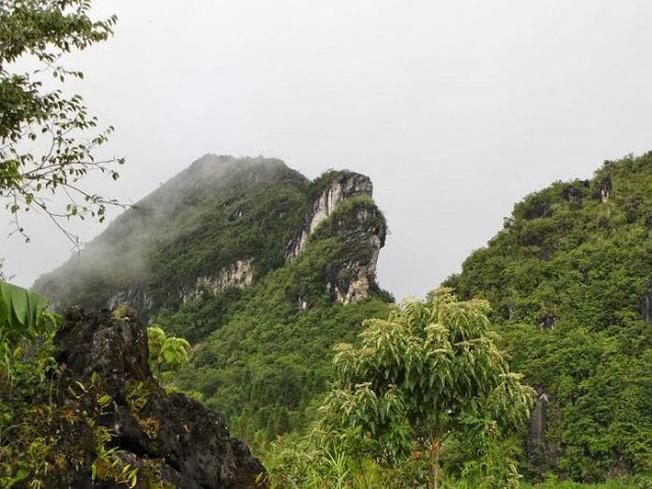
Here, you can experience the harmonious blend of sky and earth as you walk amidst the clouds. Brightly colored flowers amidst the mountain mist make you feel as if you’re in an enchanting garden. Continuing the journey higher, you’ll feel like you’ve entered a heavenly realm with familiar scenes for those who have watched the “Journey to the West” TV series, with vast rocky landscapes, various rock formations, and endless opportunities for imaginative interpretation. The path to Heaven’s Gate ahead only reveals a vast blue sky, with clouds below your feet. After reaching Heaven’s Gate 1, stop at Heaven’s Gate 2, about 1,700 meters high, to get a clear view of the Dragon’s Head. The path narrows as you enter the Tam Mon cave, where only one person can pass at a time. Exiting, you’ll find an expansive sky. The camping area here features an orchard with three main fruit varieties: apricots, pears, and plums. It’s not just the most beautiful viewpoint in Sapa; Ham Rong Mountain is also known as an alpine garden with blooming flowers year-round.
Here, you can also experience the cultural values of ethnic minorities by watching the traditional music performances of Mong boys and girls or dressing up as “Village Boys and Girls.” It’s truly like a miniature Sapa where you can appreciate the convergence of nature, culture, and people of the highland town with every step from Ham Rong Gate up to the mountain.
Stone Church (Nha Tho Da)
Built in 1935 (early 20th century), this structure was designed and constructed by French architects. It is considered the only remaining intact French architectural landmark in Sapa. Additionally, as a structure built very early in the area’s history, the Stone Church has witnessed many historical events alongside the land and its people. The church has undergone several renovations but still maintains its original appearance. The Stone Church occupies a prime location with Ham Rong Mountain behind it, covering an area of 6,000 square meters. The church complex consists of 7 sections, each measuring 500 square meters, with a bell tower standing 20 meters tall. Inside the church is a bell weighing half a ton, and all parts of the church are constructed from local stone, a mixture of sand, lime, and molasses. The most attractive feature of this church is its Gothic Romanesque architecture, especially evident in the roof, bell tower, and arches, creating an airy and elegant structure. In front of the church is a spacious courtyard, where ethnic minority people often gather for trade. Inside the church is a cathedral with 32 stained glass windows depicting the mysteries of the Holy Rosary, saints, and the Stations of the Cross.
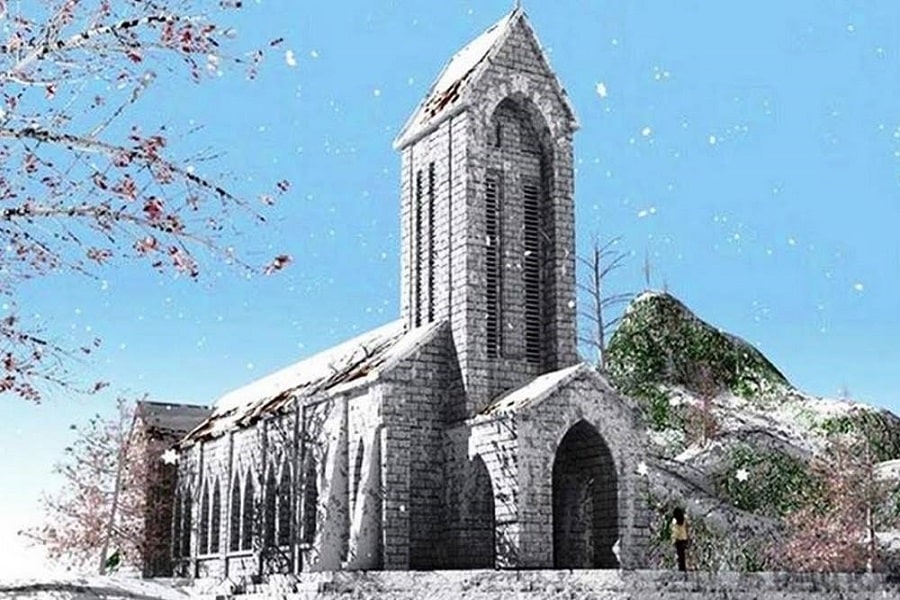
From ancient times to the present, the Stone Church of Sapa has been a venue for traditional cultural activities of the local ethnic groups. If you visit on Saturdays, you can witness the unique cultural activities of the ethnic minority people, often referred to by tourists as the “love market.” Additionally, on weekends, there are prayer activities with H’mong children singing hymns. Moreover, you can visit the moss-covered and ancient villas, each with its own unique charm, creating a distinctive backdrop of an “ancient castle in the mist.” Especially when those distant shadows faintly appear in the misty atmosphere, it’s bound to leave a lasting impression. Anyone who visits here will never forget the dense fog and the Stone Church that appears and disappears within it. Taking a commemorative photo with the Stone Church of Sapa is undoubtedly a desire of every traveler when setting foot in this beautiful land.
Muong Hoa Valley
Located 10 kilometers southeast of Sapa town, Muong Hoa Valley is an attractive tourist destination that draws the footsteps of travelers. Muong Hoa Valley captivates visitors with its serene beauty where the land and sky come together harmoniously. This stunning valley is home to various ethnic communities and encompasses breathtaking natural beauty that enchants travelers from afar. Muong Hoa Valley is one of the famous and captivating tourist spots in Sapa. In addition to its romantic charm, Muong Hoa Valley also entices visitors with its mysterious ancient rock field, nestled amidst lush vegetation and terraced rice fields of ethnic communities. Hundreds of sandstone rocks bear engravings of strange symbols and images whose origins and meanings remain undetermined to this day. Today, this ancient rock carving site has been designated as a national heritage, representing a unique part of Vietnam’s ancient history. Particularly in Muong Hoa Valley, there are 196 bizarre carvings of ancient residents from tens of thousands of years ago that many archaeologists have yet to decipher. This rock carving area has also been classified as a national heritage site.
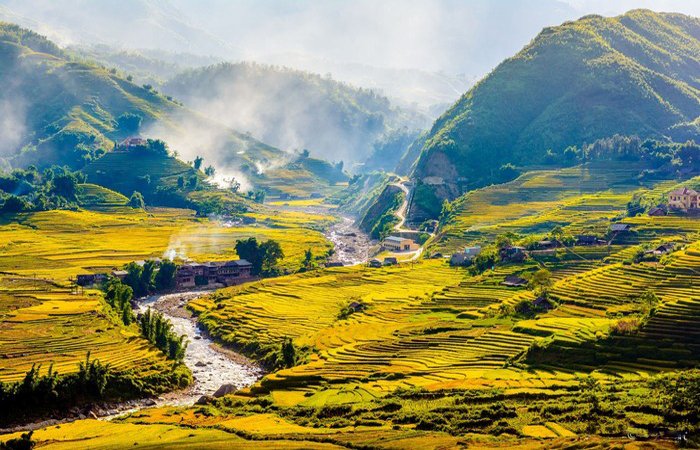
Silver Waterfall (Thac Bac)
Located about 12 kilometers from Sapa town, the waterfall has a height of approximately 200 meters and is situated right beneath the O Quy Ho Pass. It serves as the upper source of the stream within the Muong Hoa Valley. Standing at the foot of this gem of a waterfall, you can admire its extraordinary beauty. With the roaring water crashing down and creating white foamy sprays, along with the echoing sound reverberating through the mountains and forests, it creates a wild and mystical atmosphere. The surrounding area of the Silver Waterfall is covered in lush vegetation year-round. Especially during the winter, the Silver Waterfall area is the place with the thickest snow in the Sapa tourist area.
Cat Cat Village (Ban Cat Cat)
Cat Cat Village, also known as Cat Cat Hamlet, is a small village located 2 kilometers from Sapa town. Cat Cat Village in Sapa was established in the mid-19th century by a minority group that gathered together following a secret method of living, relying on the mountain slopes and huddling close to each other, with houses spaced several dozen meters apart. They lived and cultivated on the hillside fields. The natural scenery and the beauty of Mong culture here have made Cat Cat an irresistibly charming destination that attracts visitors to explore this village. As one of the oldest Mong villages, it preserves many traditional handicrafts such as cotton planting, linen weaving, fabric dyeing, and jewelry making. Moreover, the village still retains many unique customs that are not found elsewhere or have not remained in their original form.
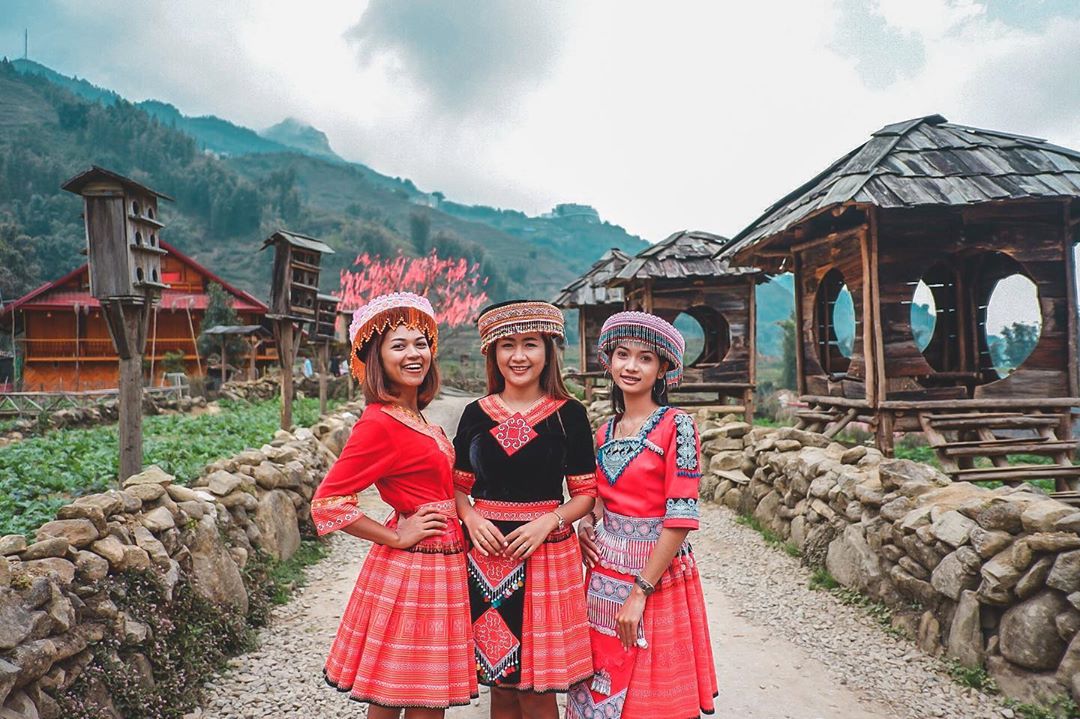
Lao Chai – Ta Van Village
Lao Chai – Ta Van is primarily inhabited by the Hmong, Dao, and Giay ethnic groups and is located about 7 kilometers from Sapa town. Despite its proximity to Sapa, it has a distinctly different character. While tourists visiting Sapa are often captivated by the hustle and bustle of city life, as well as the vibrant love market, Lao Chai – Ta Van unveils a breathtaking landscape of terraced fields that stretch from one hill to another. These terraced fields in Lao Chai – Ta Van have existed for thousands of years, constructed mainly by the indigenous people for cultivation, providing sustenance to the village for generations. Apart from the rice terraces, the green fields of corn, sweet potatoes, and cassava in the backyards of houses also create a peaceful and charming atmosphere. Standing on a vantage point, observing the ripening golden rice fields, each terrace appears like tiny, industrious caterpillars nestled amidst the vast mountains and forests of the Northwest. In this setting, with lingering morning mist, the smoke from traditional stilt houses rises, and everything in nature and human life harmoniously combines into a beautiful and gentle picture. Besides immersing oneself in the natural beauty of Lao Chai – Ta Van, travelers can also experience the local culture, such as making rice wine and weaving fabrics. In Ta Van, the tradition of stone worship is still upheld, with over 200 stones of various sizes carved into different shapes near the stream, believed to protect and bless the village with warmth and prosperity. Despite the presence of electricity and modernization, the unique beauty of the people of Lao Chai – Ta Van remains unaltered, preserving its charm throughout changing times.
Love Waterfall (Thac Tinh Yeu)
Located in the territory of San Sa Ho commune, Sa Pa district, Lao Cai province, about 4 kilometers southwest of Sapa town. The road leading to Love Waterfall is a dirt road adorned with the gentle beauty of the Rhododendron flowers, which grow on both sides of the road in bright colors of red, white, and yellow. Immersed in this beautiful scenery, you can hear the rustling sounds of the forest trees swaying in the wind. After traveling this road, you will come across a stream, and if you continue along the stream, you will reach Love Waterfall.
Sunday Market
Sapa’s Sunday Market takes place in the town center. People from distant villages have to travel from Saturday to attend. On Saturday night, everyone enjoys their time together with traditional songs of Mong and Dao boys and girls, the sounds of mouth organs, flutes, and Mong jaw harps, accompanied by the sound of traditional musical instruments. The locals call it the “love market.”
Ancient Rock Field
Stretching across the Muong Hoa Valley, located approximately 8 kilometers from the central Sapa town, this area covers about 8 square kilometers with nearly 200 rock formations. Discovered in 1925 by French archaeologists, it is considered a relic from prehistoric times. Sapa’s ancient rock field is a valuable heritage of the Northwest and Vietnam. Nearly 100 years since its discovery, this rock field continues to attract a large number of domestic and international tourists. When you have the chance to gaze upon this rock field, you’ll be amazed by the scattered rocks of various sizes throughout the land. Some are small stones hidden deep in green fields, while others are massive rocks, about 4 meters tall and 15 meters long, or small rocks about 0.5 meters wide. All of them will captivate visitors with their unique and mesmerizing beauty. The more you admire them, the harder it is to look away, as if there is an irresistibly strong and mysterious attraction. These rocks bear unique engravings, such as terraced fields, human figures, stilt houses, roads, or clearly defined writing. However, there are also many engravings that are mysterious and hard to decipher, evoking both curiosity and wonder in visitors and researchers alike.
Enjoying Coffee

While Sapa may not be famous for its coffee, it is actually one of the best places to savor hot beverages in combination with impressive scenery and unique locations.
Unique Cuisine in Sapa.
Aside from the famous tourist attractions, Sapa is also known for its unique cuisine.
Sapa Plums and Apricots:
The sweet and tempting taste of Sapa plums and apricots is renowned. During the summer season, in addition to enjoying the breathtaking mountain and village views, you can relish the sweet local fruits. In the plum season, when you visit Sapa, you should experience picking and buying plums in the orchards. If you prefer to buy them from vendors, it’s advisable to purchase from the ethnic minority people selling near the church. Sapa apricots may not look as attractive as those imported from China, but they are known for their crispy sweetness and fragrance. When traveling in Sapa during the summer, you should also buy apricots from the H’mong and Dao people selling along the roads near Sapa church.
Sapa Persimmons:
Around September, the season of Sapa persimmons (locally known as “lê Sa Pa”) and “táo mèo” (a type of apple) begins. Sapa persimmons have a slightly sour, refreshing taste, and they are smaller and less visually appealing than imported persimmons, but their quality is always guaranteed. They make excellent gifts for your loved ones when you travel to Sapa.
Sapa Sour Bamboo Shoots:
Sapa sour bamboo shoots are a local specialty that involves marinating bamboo shoots in saltwater for 20 to 30 days. When finished, the bamboo shoots have a refreshing sour taste and are used in cooking with fish or meat. They are a delightful addition to local dishes. The most popular Sapa sour bamboo shoots are the ones prepared by the highland locals. The bamboo shoots are carefully selected, about 25-30cm in height, and are cut into thin slices without retaining excess water.
Sapa Bamboo Sprouts:
Known for their sweet and slightly bitter taste, Sapa bamboo sprouts have a unique charm that captures the hearts of tourists. They are called “măng vầu” because they are the new, tender shoots of bamboo, about 20-30cm in height, which the local people harvest and process into three specialty dishes: boiled bamboo sprouts dipped in fish sauce, sour bamboo sprouts, and dried bamboo sprouts. Each dish has its own distinct flavor, but they are all delicious.
Sapa Mushrooms:
As the first rains of autumn begin to fall, it marks the start of the mushroom season in Sapa. Sapa mushrooms have a sweet taste and a delicate aroma. When visiting Sapa during this time, it’s a good idea to pick up some fresh mushrooms to prepare meals for your family or to bring as gifts to your loved ones. If you are nearby, you can buy fresh mushrooms from the local ethnic minority people. If you are traveling from a distance, it’s advisable to buy dried mushrooms for easier storage and transportation during your tour. Please note that Sapa forest mushrooms have thin wings, a bright color, and are different from cultivated mushrooms.
Sapa “Lợn Cắp Nách” (Pig Carried Under the Armpit):
The “lợn cắp nách” in Sapa refers to pigs that are raised freely on the mountains and hills. They forage for food on steep slopes throughout the year, enduring the cold weather, which makes the meat of this breed lean and tough. A mature “lợn cắp nách” usually weighs less than ten kilograms. When preparing the pork, it is cleaned, seasoned, and then roasted or grilled. The thin slices of meat, from the outer layer to the inside, consist of a crispy skin, followed by tender, sweet, and thin meat, which is less than 2 cm thick. The innermost part is bone, usually very small and soft, and can be eaten if it’s not the long bone.
Black Chicken (Evil Chicken)
The most famous dish made from black chickens in Sa Pa is honey-grilled black chicken. This aromatic grilled chicken, served with mint leaves and a dipping sauce made from salt and lime pepper, is sure to satisfy even the most discerning diners. The black chicken, a special breed among the H’mong people, has black skin, meat, and bones. The meat is firm, flavorful, and the crispy skin adds a unique texture to the dining experience. Studies have shown that black chicken not only enhances “romantic” prowess but also has special medicinal properties for heart-related conditions.
Stream Fish
There are several types of stream fish in Sapa, including flat-bodied whitefish, flower fish, and “cá bống,” as well as some species with a mixture of black and mossy colors. Sapa stream fish are usually small, no larger than a finger, with the biggest ones being the size of a knife handle. What makes these fish unique is that they have no fishy taste. Tourists usually catch the fish and grill them right by the stream to enjoy fresh fish or sell them to restaurants in town.
Sapa Grilled Dishes
Many tourists say that if you visit Sa Pa and don’t try the grilled dishes, you haven’t fully explored the unique and diverse culinary culture of Sa Pa. Among the many delights to savor in the extensive dining experience of Sa Pa, Sapa grilled dishes are becoming a distinct “brand” that sets it apart from other regions.
Buffalo “Gác Bếp” Meat
Buffalo “gác bếp” meat is available in abundance in Sa Pa. To get the best quality buffalo meat from the H’Mong people, you should buy it in the ethnic minority villages during your visit. One of the special specialties of Sa Pa is buffalo “gác bếp” meat. Therefore, a unique souvenir from a Sa Pa trip is this smoked buffalo meat, which is preserved by hanging it over a wood stove in the homes of the ethnic minority people.
“Thắng Cố” (Hotpot)
“Thắng cố” is typically served with various types of dipping vegetables like “cải mèo” (cat’s ear vegetable), water morning glory, and hotpot greens. To enjoy “thắng cố,” it’s recommended to pair it with corn wine, a strong, aromatic liquor crafted from the essence of the mountains and forests. When the food and drink blend together, it creates a pleasant and unforgettable experience. “Thắng cố” is a specialty of the H’Mong people and can be found in their villages and markets. Sa Pa’s “thắng cố” is primarily made from horse meat, and a pot of “thắng cố” contains meat, heart, liver, lungs, and horse intestines, along with 12 different spices, including medicinal herbs. When served, the broth is poured into the hotpot, and thinly sliced horse meat is added for cooking.
Corn Cake
From June to October, some ethnic groups in Sa Pa often make corn cakes. The ingredients for making corn cakes include corn and glutinous rice, which are ground into a dough. Then, the dough is filtered through a cloth until it dries to a consistency suitable for wrapping. The ratio of corn to glutinous rice is 2:1. After that, the dough is molded into small cakes using a bowl, wrapped in banana leaves, tied, and steamed like corn cakes. The finished cakes have the fragrance of glutinous rice and corn, and when eaten, they have a refreshing, chewy texture similar to the rice cakes made by the Kinh people. Corn cakes can be stored in a dry place for several days without spoiling.
Ethnic Liquor
There are two famous types of liquor in Sa Pa: apple liquor and Sán Lùng liquor, both of which are brewed by the ethnic minority people using wild fruits and forest leaves. Apple liquor is made from the wild apple fruit, which has a unique apple aroma and a slightly sweet and bitter taste when consumed. On the other hand, Sán Lùng liquor is brewed using traditional yeast of the Dao Do ethnic group. Therefore, when you leave Sa Pa after your summer trip, don’t forget to buy these two local spirits as souvenirs. You can buy pure apple liquor at the market of the H’Mong people, while Sán Lùng liquor is available at the market of the Dao Do people. In particular, for Sán Lùng liquor, you can visit the Sán Lùng village in Bản Xèo, Bát Xát district, to enjoy and purchase high-quality liquor.
Mường Khương Chili Sauce
If you’ve traveled to Sa Pa and didn’t bring back this chili sauce as a gift, you’ve missed out. You can buy Mường Khương chili sauce at various specialty stores in Sa Pa at very reasonable prices. Mường Khương chili sauce is made from a special type of chili combined with garlic, sesame seeds, coriander seeds, basil seeds, fennel seeds, cloves, salt, alcohol, and water in a traditional ratio, making it unique and famous everywhere.
With such enticing and unique features, what are you waiting for? Put on your backpack and go. Come to experience, come to explore, come to indulge. Quickly experience Sapa with a Hanoi – Sapa outdoor tour, my friend!